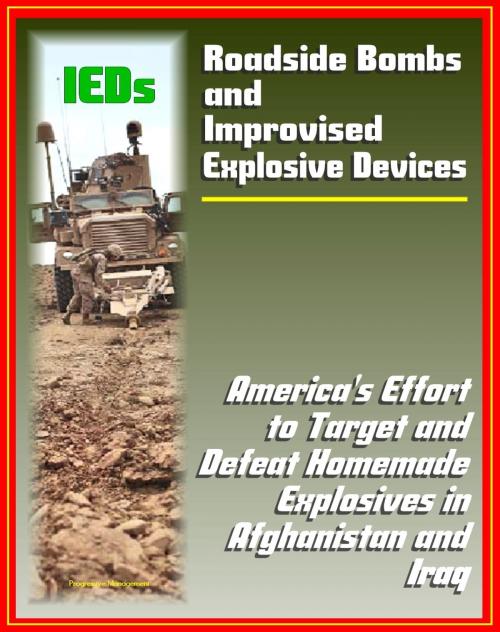Roadside Bombs and Improvised Explosive Devices (IEDs) - America's Effort to Target and Defeat Homemade Explosives in Afghanistan and Iraq - Electronics, Surveillance, Dogs, and More
Nonfiction, Science & Nature, Technology, Military Science, Social & Cultural Studies, Political Science| Author: | Progressive Management | ISBN: | 9781458132826 |
| Publisher: | Progressive Management | Publication: | May 19, 2011 |
| Imprint: | Smashwords Edition | Language: | English |
| Author: | Progressive Management |
| ISBN: | 9781458132826 |
| Publisher: | Progressive Management |
| Publication: | May 19, 2011 |
| Imprint: | Smashwords Edition |
| Language: | English |
The threat of improvised explosive devices (IEDs) and roadside bombs to American and coalition troops in Afghanistan and Iraq, and America's efforts to target and defeat those explosives, is the subject of this comprehensive report, compiled from numerous official documents. Updated with the latest information from the Joint IED Defeat Organization (JIEDDO), it also includes the results of Congressional inquiries into jamming the IED assembly line by impeding the flow of ammonium nitrate in south and central Asia. A recent GAO report on the JIEDDO effort is also reproduced.
The JIEDDO solicitation of proposals for the development of innovative capabilities to defeat IEDs employed against dismounted U.S. or coalition forces anywhere in the world, but especially in Afghanistan is included. The military is looking for advances in the dismounted detection of buried IEDs and unmanned ground vehicles for dismount support. Buried IEDs are emplaced on or under the ground to be detonated in the proximity of Coalition Forces or other passers-by. IEDs are used on roadways, paths and choke points where intended victims are likely to walk. Devices are frequently emplaced in or near features (e.g. washouts, culverts, gates and bridges) that conceal their signatures and channel traffic over them. Components common to an IED are a switch, an initiator, a power source, and the main charge with container. The main charge is typically a homemade, fertilizer-based, bulk explosive in a plastic or fabric container.
The most common switches for buried IEDs are victim operated pressure switches and command wires. Pressure switches close a contact when compressed by a foot or wheel. They are emplaced under light overburden near the main charge. The modular design of IEDs enables detection strategies that address any of the components or the wires that connect them. Common pressure switches are fabricated from lightweight conductive components that are held apart by non-conductive flexible or collapsible spacers. Common conductors are nails, foil and wire. Metal content is deliberately minimized and batteries may be buried deeply or offset from the anticipated path of the victim. Command wires lead from a remote firing point to the main charge. The wire will be hidden from view and may be buried.
IEDs are the enemy's fires system - their artillery. In Iraq and Afghanistan, the enemy delivers these fires through networks that for centuries have formed the sinews of commerce for tribes and factions. IED attacks provide the enemy with a cheap, stand-off, precision targeting system that often provides attackers with complete anonymity. Coverage of IEDs and the JIEDDO includes: JIEDDO Annual Reports (including the newest for the Fiscal Year 2010), Acronyms and Terms, Glossary, DoD Directives, Urgent Needs and Readiness Levels, Technology Readiness Levels, Training for Forensics and Crime Scene Investigation to Battle IEDs, biographies of key officials in the JIEDDO, History of JIEDDO, The Threat, Organizational Structure, Organization Chart, Attacking the Network, Counter-IED Operations Integration Center (COIC), Keyhole, Information Operations, Intelligence, Surveillance, and Recon (ISR), Warrior Alpha, WTI, Constant Hawk, Technology Insertion Process, Identity InstaCheck, Palantir, Data Tracker, Doing Business with JIEDDO, Defeat the Device: Ahura, Lapeer and Terrapin, Husky Mounted Detection System, Counter Radio-controlled Electronic Warfare (CREW), DUKE, Chameleon, Guardian, Vehicle Optics Sensor System (VOSS), Route Clearance Teams (RCT), Route Clearance Blowers, MARCBot/Xbot, Healy Beacon, Rhino II and III, Combat Tracker Dogs, Training the Force, JTCOIC, Tactical Site Exploitation. GAO Report on Warfighter Support: Actions Needed to Improve Visibility and Coordination of DOD's Counter-Improvised Explosive Device Efforts.
The threat of improvised explosive devices (IEDs) and roadside bombs to American and coalition troops in Afghanistan and Iraq, and America's efforts to target and defeat those explosives, is the subject of this comprehensive report, compiled from numerous official documents. Updated with the latest information from the Joint IED Defeat Organization (JIEDDO), it also includes the results of Congressional inquiries into jamming the IED assembly line by impeding the flow of ammonium nitrate in south and central Asia. A recent GAO report on the JIEDDO effort is also reproduced.
The JIEDDO solicitation of proposals for the development of innovative capabilities to defeat IEDs employed against dismounted U.S. or coalition forces anywhere in the world, but especially in Afghanistan is included. The military is looking for advances in the dismounted detection of buried IEDs and unmanned ground vehicles for dismount support. Buried IEDs are emplaced on or under the ground to be detonated in the proximity of Coalition Forces or other passers-by. IEDs are used on roadways, paths and choke points where intended victims are likely to walk. Devices are frequently emplaced in or near features (e.g. washouts, culverts, gates and bridges) that conceal their signatures and channel traffic over them. Components common to an IED are a switch, an initiator, a power source, and the main charge with container. The main charge is typically a homemade, fertilizer-based, bulk explosive in a plastic or fabric container.
The most common switches for buried IEDs are victim operated pressure switches and command wires. Pressure switches close a contact when compressed by a foot or wheel. They are emplaced under light overburden near the main charge. The modular design of IEDs enables detection strategies that address any of the components or the wires that connect them. Common pressure switches are fabricated from lightweight conductive components that are held apart by non-conductive flexible or collapsible spacers. Common conductors are nails, foil and wire. Metal content is deliberately minimized and batteries may be buried deeply or offset from the anticipated path of the victim. Command wires lead from a remote firing point to the main charge. The wire will be hidden from view and may be buried.
IEDs are the enemy's fires system - their artillery. In Iraq and Afghanistan, the enemy delivers these fires through networks that for centuries have formed the sinews of commerce for tribes and factions. IED attacks provide the enemy with a cheap, stand-off, precision targeting system that often provides attackers with complete anonymity. Coverage of IEDs and the JIEDDO includes: JIEDDO Annual Reports (including the newest for the Fiscal Year 2010), Acronyms and Terms, Glossary, DoD Directives, Urgent Needs and Readiness Levels, Technology Readiness Levels, Training for Forensics and Crime Scene Investigation to Battle IEDs, biographies of key officials in the JIEDDO, History of JIEDDO, The Threat, Organizational Structure, Organization Chart, Attacking the Network, Counter-IED Operations Integration Center (COIC), Keyhole, Information Operations, Intelligence, Surveillance, and Recon (ISR), Warrior Alpha, WTI, Constant Hawk, Technology Insertion Process, Identity InstaCheck, Palantir, Data Tracker, Doing Business with JIEDDO, Defeat the Device: Ahura, Lapeer and Terrapin, Husky Mounted Detection System, Counter Radio-controlled Electronic Warfare (CREW), DUKE, Chameleon, Guardian, Vehicle Optics Sensor System (VOSS), Route Clearance Teams (RCT), Route Clearance Blowers, MARCBot/Xbot, Healy Beacon, Rhino II and III, Combat Tracker Dogs, Training the Force, JTCOIC, Tactical Site Exploitation. GAO Report on Warfighter Support: Actions Needed to Improve Visibility and Coordination of DOD's Counter-Improvised Explosive Device Efforts.















